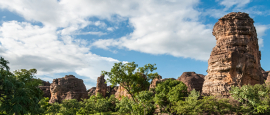A series of waterfalls and swimming pools along the Komoé River, Karfiguéla Falls are a great place to both cool down and enjoy the natural beauty of the area. Though permanently flowing, the falls are at their best in or just after the rainy season, which can make reaching them by road an experience in itself.
Burkina Faso things to see and do
The lifeblood of Bobo Dioulasso, the largest town inhabited by the Bobo people, are the attractive streets around its bustling market, the Grand Marché. Other city attractions are the Musée Provincial du Houët with regional relics, arts and crafts, and the spectacular mud-brick Grande Mosquée in the Kibidwé district.
The best areas for hiking are in the southwest of the country, around the Banfora escarpment, which offers excellent views of the whole region. The Sénoufo region, west of Banfora, is also very pleasant, as is the Lobi region around Gaoua, southeast of Bobo Dioulasso. Mountain bike trips can also be arranged in these areas for those seeking adrenaline.
The seemingly endless geological landscape of fracturing peaks around Sindou provides a spectacular, and peaceful, contrast to Burkina Faso’s rapidly growing cities. Eroded into their current shapes by water over millennia, and heavily wrapped in local folklore, the peaks are one of the country’s finest natural wonders.
Tiébélé’s royal court is a large traditional Sahelian compound of vibrantly painted and windowless mud huts that are home to some 450 people. With low doorways and dark interiors these structures are traditionally built in a figure of 8. Black, brown, and white symbolic geometric designs adorn the outer walls, and are refreshed annually in February or March.
Held every two years in the capital, Ouagadougou, the International Arts and Crafts Fair is one of Africa’s most important trade shows and has been popular with bargain hunters since its inception in the early 1980s. Visitors can buy anything from jewellery and textiles to carvings and intricate metal work.
An important centre of the Mossi Empire since the 15th century, Ouagadougou’s Ethnography Museum contains a substantial collection of Mossi artefacts. It became the permanent residence of the Moro-Naba emperor in 1681. The Bangr-Weoogo urban park, once the tribe’s sacred forest, provides the city with some much needed green space. Pabre, an ancient Mossi village, is a short distance away.
Given Burkina Faso’s dry climate its four national parks – Kaboré Tambi, Deux Balés, Arli and W – are perhaps surprisingly well-stocked, home as they are to some of Africa’s most renowned wildlife including elephant and big cats. South of Ouagadougou, near Pô, the Reserve de Nazinga has a large population of elephants, antelopes, monkeys, baboons and warthogs, so don’t forget your binoculars.
The Mare aux Hippopotames (or Hippo Lake) was created in 1937 around a fresh water lake, marshes and forests flooded by the Black Volta River. Home to around 100 hippos, it is also an important site for wetland birds. Visitors may be taken out in a pirogue to view the hippos for a small fee.
At around 0600 every Friday, the Nabayius Gou ('the Emperor goes to war') ceremony is performed at the Moro-Naba Palace in Ouagadougou. It depicts the magnificently bedecked emperor being restrained by his wife and subjects as he sets off to make war with his brother.
Do you have any Feedback about this page?
© 2025 Columbus Travel Media Ltd. All rights reserved. No part of this site may be reproduced without our written permission, click here for information on Columbus Content Solutions.








 You know where
You know where